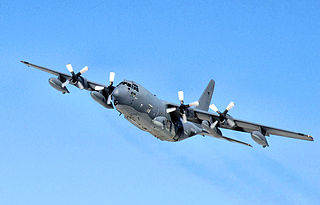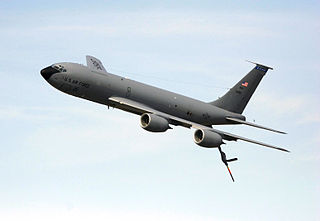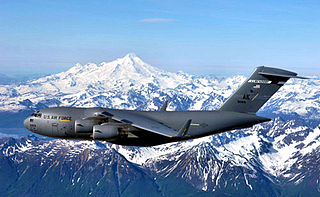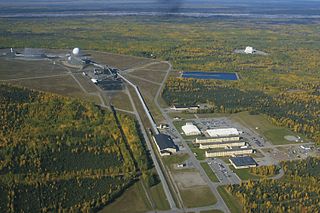
The Eleventh Air Force (11 AF) is a Numbered Air Force of the United States Air Force Pacific Air Forces (PACAF). It is headquartered at Joint Base Elmendorf–Richardson, Alaska.

The California Air National Guard (CA ANG) is one of three components of the California National Guard, a reserve of the United States Air Force, and part of the National Guard of the United States.

The Ohio Air National Guard is the aerial militia of the State of Ohio, United States of America. It is, along with the Ohio Army National Guard, an element of the Ohio National Guard.

The 168th Wing is a unit of the Alaska Air National Guard, stationed at Eielson Air Force Base, Fairbanks, Alaska. Before it was redesignated in February 2016, it was known as the 168th Air Refueling Wing. If activated to federal service as a USAF unit, the 168 WG is primarily gained by Pacific Air Forces, while its 213th Space Warning Squadron is gained by Air Force Space Command.

The Alaskan Command (ALCOM) is a joint subordinate unified command of the United States Northern Command, responsible for operations in and around the State of Alaska. Alaskan Command is charged with maintaining air sovereignty, deploying forces for worldwide contingencies as directed by the Commander, US Northern Command, providing support to federal and state authorities during civil emergencies and conducting joint training for the rapid deployment of combat forces. ALCOM combined forces include more than 16,000 Air Force, Army, Navy and Coast Guard personnel, and 3,700 guardsmen and reservists. Recently, the Command Representative for Missile Defense position was created to be the focal point for all issues related to Ground-Based Midcourse Defense in Alaska, in support of Alaskan Command, the Alaska NORAD Region, and the Eleventh Air Force.

The Wisconsin Air National Guard (WI ANG) is the aerial militia of the State of Wisconsin, United States of America. It is, along with the Wisconsin Army National Guard, an element of the Wisconsin National Guard.

The 176th Wing is a unit of the Alaska Air National Guard, stationed at Joint Base Elmendorf-Richardson (JBER), Anchorage, Alaska. If activated to federal service, components of the Wing are gained by several United States Air Force Major Commands.

The 176th Air Defense Squadron is a unit of the Alaska Air National Guard 176th Wing located at Joint Base Elmendorf-Richardson, Anchorage, Alaska.

Kulis Air National Guard Base was a National Guard of the United States facility in Anchorage, Alaska. The 127-acre (51 ha) facility adjacent to and south of Ted Stevens International Airport was home to the 176th Wing of the Alaska Air National Guard until that unit moved to Joint Base Elmendorf-Richardson in February 2011. The property thereafter reverted to ownership by the State of Alaska, which as of April 2011 had not yet announced plans for the property.

The Mississippi Air National Guard, commonly known as the Mississippi Air Guard, is the aerial militia of the State of Mississippi, United States of America. It is, along with the Mississippi Army National Guard, an element of the Mississippi National Guard.

The 144th Airlift Squadron is a unit of the Alaska Air National Guard 176th Wing located at Joint Base Elmendorf-Richardson, Anchorage, Alaska. The 144th is an associate unit of the active 517th Airlift Squadron, equipped with the C-17 Globemaster III.

The 168th Air Refueling Squadron is a unit of the Alaska Air National Guard 168th Air Refueling Wing located at Eielson Air Force Base, Fairbanks, Alaska. The 168th is equipped with the KC-135R Stratotanker.

The 210th Rescue Squadron is a unit of the Alaska Air National Guard 176th Wing located at Joint Base Elmendorf-Richardson, Anchorage, Alaska. The 210th is equipped with the HH-60G Pave Hawk helicopter.

The 211th Rescue Squadron is a unit of the Alaska Air National Guard 176th Wing located at Joint Base Elmendorf-Richardson, Anchorage, Alaska. The 211th is equipped with the HC-130J Hercules.

The 212th Rescue Squadron is a unit of the Alaska Air National Guard 176th Wing stationed at Joint Base Elmendorf-Richardson, Anchorage, Alaska. The squadron has no assigned aircraft; personnel assigned use aircraft of the 210th and 211th Rescue Squadrons of the Wing.

The 191st Air Refueling Squadron is a unit of the Utah Air National Guard 151st Air Refueling Wing located at Roland R. Wright Air National Guard Base, Utah. The 191st is equipped with the KC-135R Stratotanker.

The 249th Airlift Squadron is an inactive unit of the Alaska Air National Guard, formerly located at Joint Base Elmendorf–Richardson, Alaska and assigned to the 176th Wing. The 249th was an associate unit of the 517th Airlift Squadron, which was equipped with the Boeing C-17 Globemaster III.

Elmendorf Air Force Base is a United States Air Force (USAF) facility in Anchorage, Alaska. Originally known as Elmendorf Field, it became Elmendorf Air Force Base after World War II.

The 213th Space Warning Squadron of the Alaska Air National Guard provides early warning of Intercontinental ballistic missiles and Submarine-launched ballistic missiles to the Missile Correlation Center of North American Aerospace Defense Command. The squadron is a geographically separated unit assigned to the 168th Wing at Eielson Air Force Base.

Joint Base Elmendorf–Richardson is a United States military facility in Anchorage, Alaska. It is joint base formed from the United States Air Force's Elmendorf Air Force Base and the United States Army's Fort Richardson, which were merged in 2010.


























